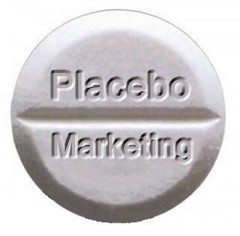Placebos, Price, and Marketing
 Hot on the heels of learning that more expensive wine tastes better, we find that more expensive placebos are more effective at controlling pain:
Hot on the heels of learning that more expensive wine tastes better, we find that more expensive placebos are more effective at controlling pain:
The investigators had 82 men and women rate the pain caused by electric shocks applied to their wrist, before and after taking a pill. Half the participants had read that the pill, described as a newly approved prescription pain reliever, was regularly priced at $2.50 per dose. The other half read that it had been discounted to 10 cents. In fact, both were dummy pills.
The pills had a strong placebo effect in both groups. But 85 percent of those using the expensive pills reported significant pain relief, compared with 61 percent on the cheaper pills. [From the New York Times – More Expensive Placebos Bring More Relief.]
Considering that pain is a sort of mind-body construct, the idea that a person’s expectations about a drug could affect perceived pain is perhaps not a great surprise (certainly not to Neuromarketing readers). Makers of brand name prescription and over the counter drugs will cheer this finding, though it’s likely that a few have already spotted this phenomonon already. I’d guess the only reason we haven’t seen ads showing that “Bayer aspirin reduces pain 25% better than generic aspirin” is that the FDA might take a dim view of such claims.
As interesting as the improved performance of high-priced placebos is, I think that most press coverage of this story will miss the really exciting points:
1. Placebos at ALL price levels work. Nobody should doubt the effect that expectations can have on an individual’s experience – even the cheap placebos reduced pain in more than 60% of the subjects, and the minimal act of increasing the apparent price boosted the percent to 85%. I’d guess a bit more staging – say, having a research scientist (or an actor in a lab coat) provide a complex explanation of why the “new drug” works so well, and the amazing lab results that were obtained in its initial trials – would push the percentage even higher.
2. It’s about expectations, not just price. In this experiment, price is the variable used to set the subject’s expectations. As I suggest above, there are a variety of ways to set the expectation. What if the pills had arrived ostentatiously in a locked Halliburton case and were individually packaged in a hermetically sealed tube? The article continues,
Previous studies have shown that pill size and color also affect people?s perceptions of effectiveness. In one, people rated black and red capsules as ?strongest? and white ones as ?weakest.? Other information like the country where the drugs were manufactured can also affect perceptions.
“It’s all about expectations,” said the lead researcher, Dan Ariely, a behavioral economist at Duke and the author of a new book, Predictably Irrational: The Hidden Forces That Shape Our Decisions (HarperCollins). His co-authors on the report were Rebecca Waber, Baba Shiv and Ziv Carmon.
Marketing’s Key Role
All of this shows the critical role of marketing not just in helping sell a product, but in optimizing the customer experience with it. A great product that for some reason seems a bit dubious to the customer will probably end up being less satisfactory than if the customer had higher expectations for it. (The product, of course, can’t contradict those expectations in a major way.) In short, companies that don’t ensure that their marketing sets attainable but positive expectations for their product will have less satisfied customers.
